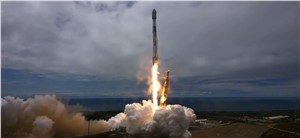Nanosats Launched That Use Light to Talk
June 14, 2023
-The satellites were developed under an ESA Partnership Project with satellite manufacturer and operator Spire Global based in Glasgow in the UK.
Spire Global’s constellation of satellites provides global weather intelligence, ship and plane movements, and spoofing and jamming detection, to better predict how their patterns impact economies, global security, business operations and the environment.
The pair of satellites will use optical inter-satellite links to send information between themselves securely and almost instantaneously. To achieve this, they are designed to achieve the equivalent of using a laser pointer to link two satellites, each the size of a large box of cornflakes, placed 5000 km apart – equivalent to the distance from Glasgow to New York.
The pair of satellites will demonstrate the ability to send more than 1 GB of data securely between the two terminals during a short contact window when the spacecraft can see each other across the Earth.
Spire Global used an agile development approach to developing its optical inter-satellite link technology, using successive iterations of the spacecraft to evolve the technology, all of which is manufactured in house.
The two satellites follow the success of an earlier pair of spacecraft that were launched in June 2021. These have been used to develop core capabilities required for optical inter-satellites links, such as advanced spacecraft pointing and position control, along with the laser beam operation and optical receivers.
The satellites were developed in partnership with ESA and the UK Space Agency within the Pioneer programme as part of ESA’s programme of Advanced Research in Telecommunications Systems (ARTES).
Seven Pioneer Partnership Projects have now been signed.
Jeroen Cappaert, Chief Technology Officer and co-founder of Spire Global, said: “We are celebrating the culmination of more than three years of work in creating one of the most complex systems from both the hardware and mission perspectives. The use of optical links instead of traditional radio frequency links leads to higher resiliency to interference, higher security and higher efficiency.
“We are one of the first to successfully qualify and demonstrate this technology in our satellite size and weight class – our part in a growing trend, as the space industry is moving to optical links as the backbone for sending data. The successful execution of this programme at this accelerated timeline would not have been possible without the expert support of ESA and the UK Space Agency.”
Craig Brown, Director of Investment at the UK Space Agency, said: “The successful launch of these two Glasgow-made satellites from Spire Global marks a milestone, not just for the company, but for how we look at intersatellite communications and make these technologies more efficient. Such leading-edge technology offers an exciting opportunity for the UK to thrive in the commercial space age while remaining committed to reducing impact on the planet.
“The UK Space Agency provided £2.9 million towards the project, which includes five satellites across three launches, through ESA’s ARTES Pioneer Programme, dedicated to supporting new commercial opportunities in the telecommunications sector. We look forward to following the next steps of Spire Global’s journey and seeing the results.”
Javier Benedicto, acting Director of Connectivity and Secure Communications at ESA, said: “ESA’s Pioneer Partnership Projects increase the competitiveness of the European space industry by supporting the emergence of new space mission providers. We are delighted to work with Spire Global and the UK Space Agency to foster innovation to enable the European space industry to succeed in highly competitive global markets.”
Source : European Space Agency (ESA)

Related Studies

Free-Space Optical Communication (FSOC) - Market and Technology Forecast to 2033
Publish date: July 2025 - Pages: 146

Small Satellites - Market and Technology Forecast to 2033
Publish date: June 2025 - Pages: 256